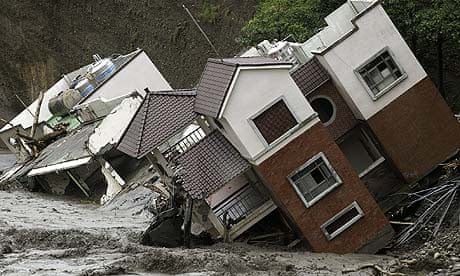The first witness accounts of the terrifying moment when a mudslide buried a Taiwanese village have emerged, as rescuers warned that more than 700 people were trapped and had possibly died in the incident caused by typhoon Morakot.
Helicopters have plucked about 300 people from mountainous Kaohsiung county, in the south of the island, but rescuers are still struggling to reach survivors as rain continues. One helicopter crashed into a mountain in nearby Pingtung county with three crew members on board.
One villager told Taiwan's China Times newspaper that she fled with her husband and baby minutes before their home was buried. "We heard two loud bangs ... The sky was filled with dust like a volcanic eruption, and flood waters, mud and rocks streamed onto the roads," she said.
In China, the government warned of the potential for secondary disasters as heavy rain persisted in the south and 20 rivers hit flood alarm levels.
More than 100 people across the Asia-Pacific region, including 62 in Taiwan, have been confirmed dead since the typhoon hit the Philippines, Taiwan and China and tropical storm Etau pummelled Japan, where it claimed 13 lives. The storms have caused hundreds of millions of pounds of damage.
Hu Jui-chou, a Taiwanese army major-general involved in rescue operations, said the 700 or more still trapped included residents trapped by a massive landslide in Hsiao-lin and a second village, Namahsia, in Kaohsiung.
"Trapped means they could be dead or alive," Hu said by telephone.
"It very likely covers people buried in the Hsiao-lin mudslide."
Lee Chin-long, 50, told Associated Press he watched as walls of mud and rock wiped out most of the village.
"I was watching from my house upstairs. The whole mountain just fell off. When I saw that, I started to run," said Lee, from Cishan, the hub of rescue operations.
"Almost every house was gone, except for a couple."
One rescued resident, Lin Mei-ying, begged the military to step up efforts, telling the television station ETTV: "There are still a lot of people trapped inside ... please go faster so they can be saved."
According to Taiwanese television reports, a mudslide may have buried another village in Pingtung county. Local media also suggested ten other villages may have been seriously damaged, but poor communications and the destruction of roads and bridges is making it hard to assess the scale of the problems. Earlier today Taiwan's fire service reported that tens of thousands were stranded.
Footage showed the streets of a village near Hsiao-lin covered by thick mud and rubble. According to reports, a 51-year-old man was swept 1.2 miles (2km) as the mudslides rushed down a nearby mountain, surviving by holding onto a log.
It is thought the typhoon hit at around 6am local time, as many householders were sleeping. One survivor told police his family of 10 had been wiped out, the Associated Press reported. "They are gone," he said, according to a local photographer who overheard the exchange.
In China, Morakot destroyed 10,000 homes and caused an estimated 9.7bn yuan (£860m) of damage, state media said. The finance ministry offered 102m yuan (£9m) in emergency aid.
Hui Liangyu, the vice-president, warned that big floods were still likely as heavy rain continued and more than 20 rivers reported water levels above flood-alarm lines in Zhejiang, Fujian and Anhui provinces, although Morakot has now been downgraded to a tropical storm.
In Japan, Etau approached the island's central area and Tokyo, hours after a 6.5 magnitude earthquake tossed food and bottles from store shelves, disrupted transport and shut down a nuclear power plant for safety checks.
Japan's weather agency warned of possible landslides and flooding, as the quake followed heavy rain. Footage showed one motorway partially washed out.
